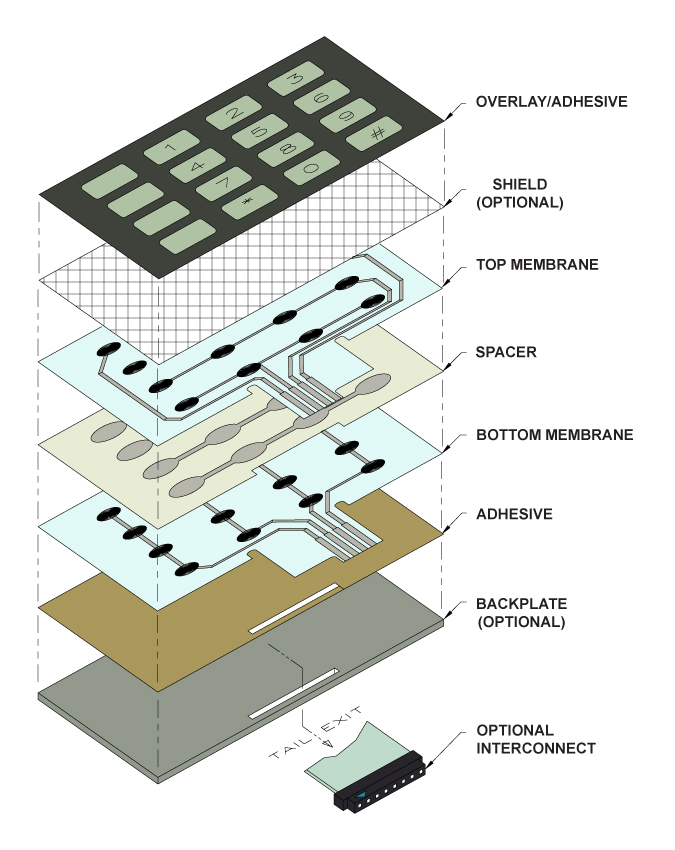The Function of a Membrane Switch in Modern Touch Interfaces and Controls
The Function of a Membrane Switch in Modern Touch Interfaces and Controls
Blog Article
Recognizing the Performance of Membrane Changes for Interface Tools
The capability of membrane changes stands for a significant improvement in individual interface style, incorporating efficiency with visual flexibility. As industries increasingly prioritize user experience, recognizing the nuances of membrane layer button innovation ends up being vital.
What Are Membrane Switches?
Membrane switches are cutting-edge user interface devices that assist in customer communication with digital equipment. These functional parts contain multiple layers, including a graphic overlay, spacer, and a printed circuit layer. The layout permits a smooth assimilation right into numerous digital tools, boosting both the aesthetic and useful facets of interface.
Membrane layer buttons are generally used in a vast array of applications, from household appliances to commercial equipment and clinical devices. Their building normally features a slim account, making them a perfect option for compact designs. The responsive responses supplied by these switches can be engineered to fulfill details individual preferences, guaranteeing efficient interaction between the individual and the gadget.
Sturdiness is another significant benefit of membrane layer switches, as they are resistant to dirt, dampness, and chemicals, which improves their lifespan popular settings. In addition, these switches can be customized in regards to shape, dimension, and visuals style, permitting branding and user-specific features. In general, membrane layer changes represent a sensible option for enhancing customer experience in digital devices, incorporating performance with aesthetic allure in an effective manner.
Just How Membrane Switches Over Work
Operating on an uncomplicated principle, membrane switches over utilize a split construction to sign up customer input successfully. Each switch includes several layers, consisting of a published circuit layer, a spacer layer, and a top visuals layer, which are designed to collaborate effortlessly. When a user presses the leading layer, it compresses the spacer layer, bringing the conductive aspects of the circuit layer right into contact with each various other.
This contact produces a shut circuit, signaling the gadget to carry out a particular feature. The layout enables different setups, including responsive comments, which can boost the user experience by offering a physical feeling upon activation. The products used in membrane switches usually include versatile substratums, such as polyester or polycarbonate, which ensure sturdiness and strength against deterioration.

Key Benefits of Membrane Layer Buttons

An additional substantial benefit is their density. Membrane layer buttons are thin and lightweight, which enables manufacturers to conserve area in their devices without compromising functionality. This attribute is especially beneficial in applications where weight and volume are essential factors to consider.
Furthermore, membrane switches are immune to dirt, moisture, and chemicals, boosting their toughness. This durability extends their life-span and reduces the requirement for regular replacements, leading to expense financial savings gradually.
Additionally, the responsive responses offered by membrane buttons can be enhanced to improve look at this website individual communication. They can include functions such as elevated switches or distinct clicks, boosting use and customer experience.
Applications Across Industries
User interface devices using membrane switches prevail in a vast array of industries, showcasing their adaptability and capability. Membrane Switch. In the clinical industry, membrane layer buttons are integral to tools such as diagnostic devices and client tracking systems, where their longevity and ease of cleaning are vital for keeping health criteria. Likewise, in the automotive industry, these switches are employed in dashboard controls and infomercial systems, offering a smooth and modern-day interface for users.
In addition, the customer electronic devices market take advantage of membrane switches in devices and portable devices, where portable style and easy to use interfaces boost customer experience. Industrial applications likewise take advantage of membrane layer switches over for control board in machinery and automation systems, highlighting their toughness and resistance to harsh environments.
In the aerospace and defense markets, membrane buttons are utilized in cockpit controls and equipment, where integrity and performance under extreme problems are critical. In addition, the video gaming market increasingly includes membrane buttons in controllers and arcade makers, adding to an interesting individual experience. Generally, the adaptability of membrane layer switches enables their extensive use across numerous fields, useful source highlighting their significance in modern-day interface design.
Future Fads in Membrane Switch Modern Technology

In addition, making use of innovative materials, such as polycarbonate and polyester films, is expected to increase, providing boosted longevity and resistance to environmental stress factors. These products add to the overall long life of membrane layer switches, making them suitable for harsher commercial applications.
Furthermore, the consolidation of clever technology, consisting of IoT connection, will certainly make it possible for membrane layer buttons to interact with various other devices and systems, helping with an extra interactive individual experience. This pattern straightens with the growing demand for clever tools throughout various markets, from health care to customer electronic devices.
Lastly, personalization alternatives are prepared for to expand, allowing manufacturers to create bespoke remedies tailored to particular customer demands and choices. These growths will position membrane layer buttons as important elements in the evolution Full Report of customer interface technology.
Conclusion
In verdict, membrane switches represent a crucial improvement in user interface innovation, supplying a reliable and versatile service for varied electronic applications. As developments in product science and touch picking up innovations proceed, the performance and applicability of membrane buttons are expected to increase, strengthening their importance in modern-day digital tools.
Report this page